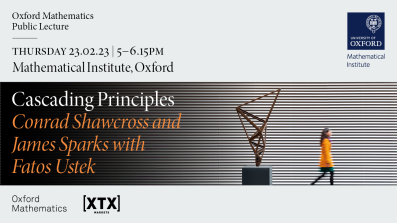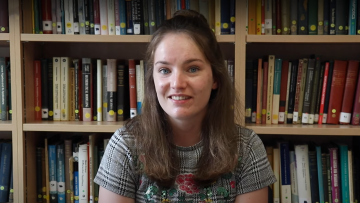Slade are most associated with the glam rock era (and Christmas) which is not surprising given what they wore, but the music has proved influential in subsequent decades on bands such as the Ramones and Nirvana. They probably had less influence on spelling bees though.
16:00
Symplectic Determinants
Abstract
The notion of a pseudocharacter was introduced by A.Wiles for GL_2 and generalized by R.Taylor to GL_n. It is a tool that allows us to deal with the
deformation theory of a residually reducible Galois representation when the usual techniques fail. G.Chenevier gave an alternative theory of "determinants" extending that of pseudocharacters to arbitrary rings. In this talk we will discuss some aspects of this theory and introduce a similar definition in the case of the symplectic group, which is the subject of a forthcoming work joint with J.Quast.
17:00
Cascading Principles - Conrad Shawcross, Martin Bridson and James Sparks with Fatos Ustek
Oxford Mathematics Public Lecture
Cascading Principles - Conrad Shawcross, Martin Bridson and James Sparks with Fatos Ustek
Thursday 23 February, 2023
5pm - 6.15pm Andrew Wiles Building, Mathematical Institute, Oxford
Cascading Principles is an exhibition of nearly 40 stunning, mathematically inspired sculptures which are living alongside the mathematicians that inspired them in the Andrew Wiles Building, home to Oxford Mathematics. In this 'lecture', chaired by exhibition curator Fatos Ustek, Conrad will talk about what motivates his work, and how the possibilities and uncertainties of science inform his art. In turn, mathematicians Martin Bridson and James Sparks will describe how a mathematician responds to art motivated by their subject.
There will be an opportunity to view the exhibition from 4pm on the day of the lecture.
Conrad Shawcross specialises in mechanical sculptures based on philosophical and scientific ideas. He is the youngest living member of the Royal Academy of Arts. James Sparks is Professor of Mathematical Physics and Head of the Mathematical Institute in Oxford. Martin Bridson is Whitehead Professor of Pure Mathematics in Oxford and President of the Clay Mathematics Institute. Fatos Ustek is a curator and writer and a leading voice in contemporary art.
Please email @email to register.
The Oxford Mathematics Public Lectures and the Conrad Shawcross Exhibition are generously supported by XTX Markets.

scrambling


